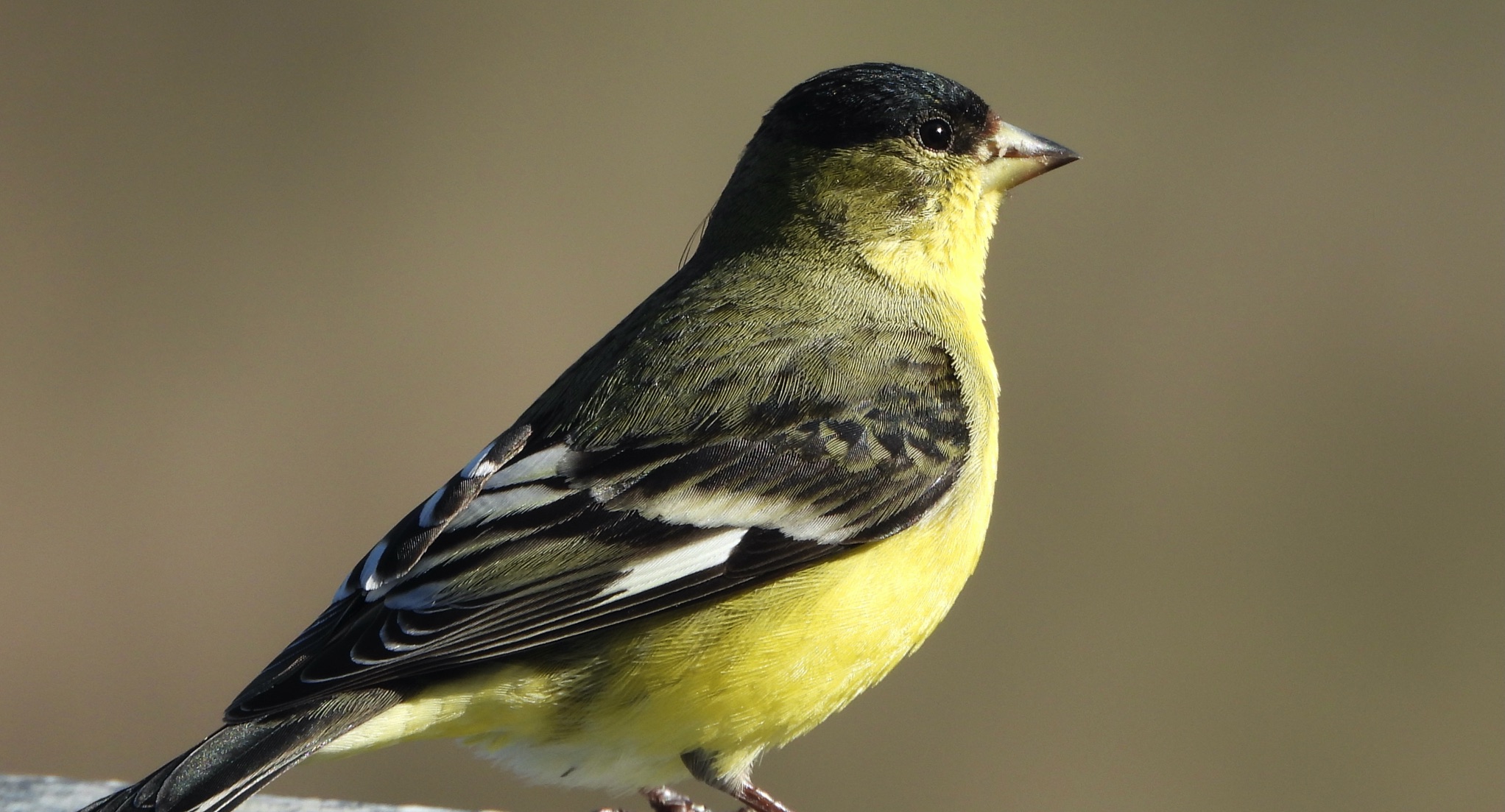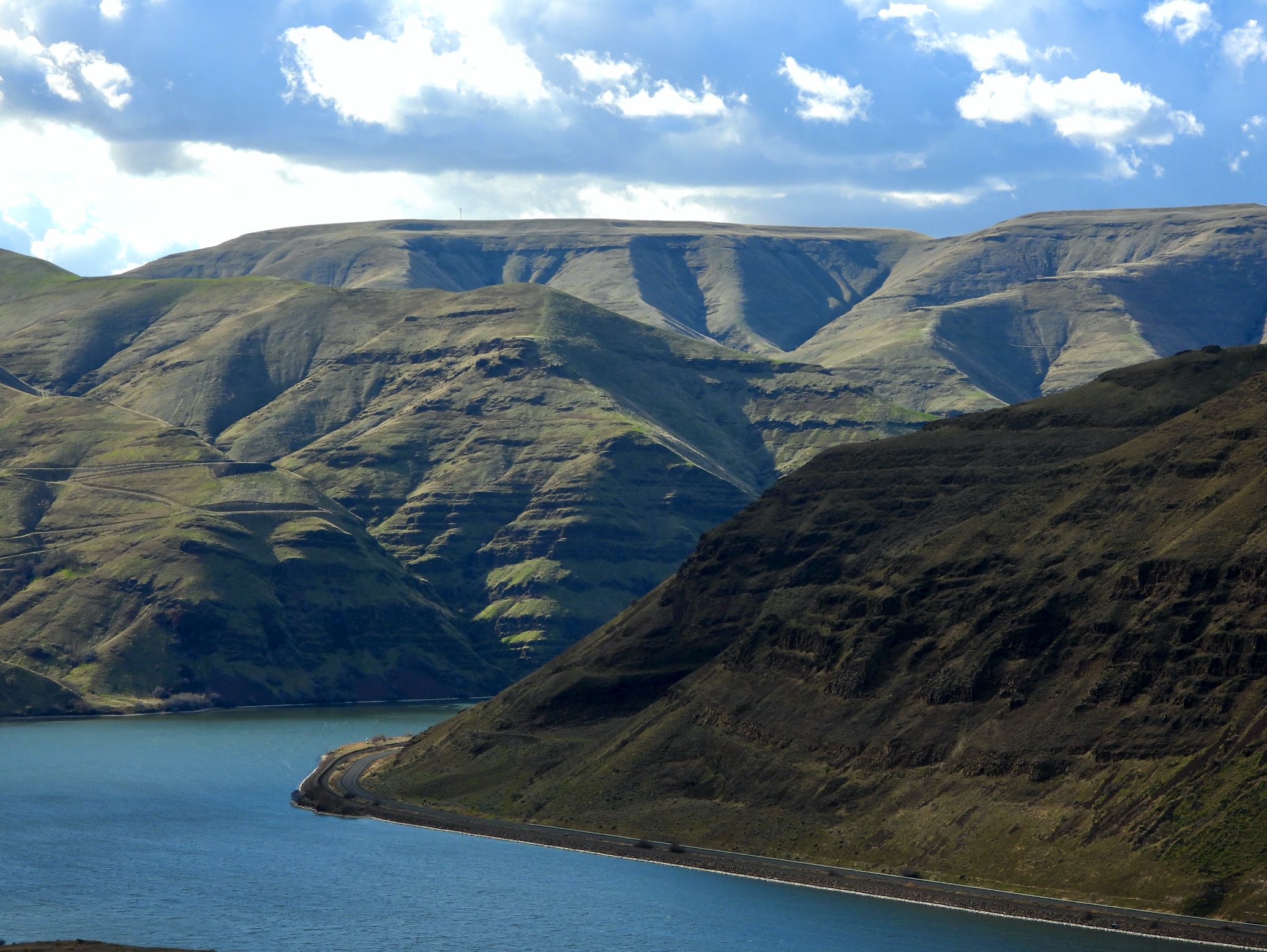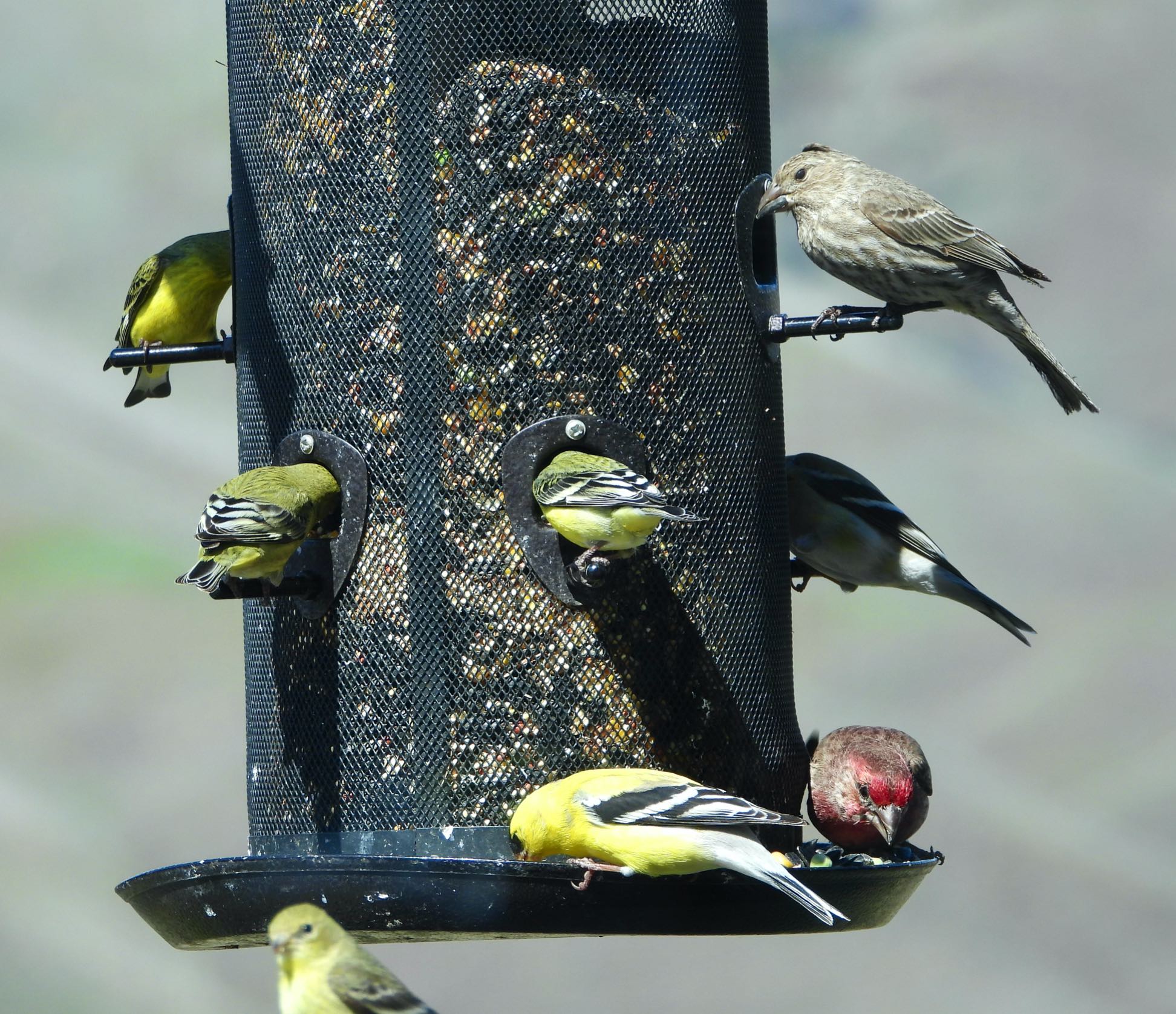
The birds of spring have been migrating through the rapidly greening Palouse Prairie and Snake River Valley for many weeks now, bringing their welcome songs to shower cheer over the early daffodils, tulips, and flowering trees. It’s been an arduous journey for many and not all make it back from wintering areas sometimes many hundreds, even thousands of miles distant from their chosen nesting grounds. But those that do survive certainly seem rather happy to begin a new season of birth and life renewal.
As an avian ecologist, I realize that bird song often reflects the intense battles of courtship and competition to find mates and secure territories to nest and raise young, but it sure doesn’t sound like that, does it? You needn’t be a research scientist to see that birds must rank among the consistently happiest creatures on Earth. Sorry Norway. Birds have you beat by miles and miles.
I’m grateful that my bird feeders provide me with such a wonderful mirror to reflect the mysteries and beauty of the avian world, even if they are just a tiny part of the much greater universe surrounding me. My wife and I live on bluffs overlooking the Snake River in Washington, but our work takes us back and forth between the valley and Pullman, a growing, but still fairly small “college town” centered around Washington State University and its surrounding rural farming community.
I’ve now lived on the river long enough to have a good sense of the seasonal ebb and flow of birds through the Snake River Valley. At times it feels like I’m starring in my own adventure movie, something like ‘The Lost World: Descent Into Snake River Valley‘ because the valley is so different than the gigantic, rolling, wave-like hills of the nearby Palouse Prairie. However, in my version of this movie, I get to have the role played by Jeff Goldblum as the eccentric scientist who espouses chaos theory and forewarns about impending environmental disasters driven by human folly. Move over Brad Pitt. There’s a new hunk in town.
When you descend the hundreds of feet down into the wide valley you enter a different and much warmer world with a climate all its own that often runs about 8-10 °F warmer than the surrounding and higher elevation Palouse Prairie. Consequently, the valley partly generates or at least moderates its own weather.

I am especially fascinated by the unique heat and cloud-forming ecology and internal climate of the river valley. Though not a physical scientist the mystery of watching clouds and fog appear, disappear, and move about in and above the winding valley channel almost makes me wish I were an atmospheric scientist who better understood the complex dynamics and dance of wind, temperature, sunlight, moisture, and other atmospheric elements and particles that must interact to produce the distinctive weather in the valley.
However, I’m not an atmospheric scientist. Instead I’m just an ordinary person more than content to watch the life-giving movements of weather, water, birds, and other animals as they flow through the valley. The river is truly an artery, with pulsating life flowing through it as water and nutrients flow from the reaches of Yellowstone National Park out to the Pacific Ocean, although some of it comes back again, partly via the nutrient-rich salmon that return much like birds to their upstream breeding grounds to lay eggs, die, and decompose so that the next cohort of life also may continue to flow through the world.
But my daily companions are birds. Lots and lots of birds. I admit to being a little excessive and compulsive, running no less than three large bird feeders. Yes, I’m on a first-name basis with my local seed-supplying farm store.
Year around, at any given moment during any given day, there might be 10-20+ House Finches (Haemorhous mexicanus) and 10-20+ Mourning Doves (Zenaida macroura) working over my feeders like a Walmart Blue Light Special. During periods of peak seasonal movements, these numbers can easily jump to 30-50+ ravenous birds of both species. And these are just the regular daily diners and ignore the Dark-eyed Juncos (Junco hyemalis) that are equally as abundant during late fall and winter. Now you see why my local farm store has dedicated a special parking spot just for me. Fortunately for me, to keep other customers like you from getting overly jealous, they’ve cleverly disguised my spot with a sign that says “Reserved for Senior Citizens.”

But wait, it gets worse. During late summer through fall, hordes of European Starlings (Sturnus vulgaris) swoop in to crash land like a black cloud falling on the patio, and though they don’t eat much seed, instead preferring insects, they devour any special peanut butter treats left out for the Black-billed Magpies (Pica hudsonia), or sometimes work over the suet feeder intended for our Red-shafted Northern Flickers (Colaptes auratus). And then in a frenzy of competitive bathing, and totally ignoring proper social etiquette let alone personal hygiene, they quickly muddy and splash all of the water out of the small bird bath, only to leave in mass as suddenly as they appeared.
Apparently Starlings have no compulsion against drinking dirty bathwater, which reminds me about my daily bird bath cleaning chores. But in spring, flocks of Starlings largely disappear as they scatter and disperse to nest, only to be replaced by equal numbers of newly arriving Red-winged Blackbirds (Agelaius phoeniceus) flying uphill from the cattail and bulrushes along the river below to trill, flash their crimson red epaulettes, and enthusiastically take over the work of destroying my monthly seed budget.
And these are just some of the most abundant birds assuming you may forget to account for the numerous Lesser Goldfinches (Spinus psaltria) that arrive in large numbers beginning in late March with American Goldfinches (Spinus tristis) appearing slightly later in April and in smaller numbers.
The arrival of the Lesser Goldfinch is a special spring treat. This living metronome marks the passage of time and seasons of my life and means that I can once again hungrily feast on the first course of spring delights, including emerging flowers, insects, bursting tree buds, and other greenery. But as somewhat of an avian Sherlock Holmes, Lesser Goldfinches also have provided me with several engaging and delightful mysteries and riddles to solve.

Maps of the Cornell Laboratory of Ornithology show that the Lesser Goldfinch is a bird with a distribution primarily in the southwestern U.S. and extending down through Mexico. Supposedly, at least according to the map, the birds shouldn’t be here, but somebody apparently forgot to tell them. There are plenty of sightings reported in Washington State according to Birds of the World maps, but these tiny finches, arguably one of the smallest true finches in the world, clearly occupy the Snake River Valley in abundance. I’ve also seen them flitting about and inspecting the emerging flower buds on green ash trees in spring in Pullman, hunting for something only their crystal-dark eyes, but not mine, can see. So I wonder if the baseline distribution maps need adjusting.
While current distribution maps of various professional birding organizations are seemingly incorrect for Lesser Goldfinches, our faithful Wikipedia does a better job of that by indicating that their range extends just into the far southwestern portion of Washington State. At least they got the Washington State part right. However, my daily observations suggest they also occupy the Snake River Valley in southeastern Washington in considerable abundance.
These inaccurate distribution maps likely will become a common problem as birds and many other organisms are forced to shift ranges in response to our rapidly warming climate. Fortunately, citizen scientists everywhere can saddle up and ride to the rescue by contributing the many thousands upon thousands of observations needed to keep distribution maps for life on Earth up to date and accurate. We all can play an important part, even with our innocuous bird feeders and backyard birding.
Though I’m not the least bit happy about climate change, and as an ecologist I am both keenly aware and deeply terrified of the biological consequences for future life on Earth, but in the here and now I am immensely happy and grateful that Lesser Goldfinches cheerfully grace my life and my feeders daily like tiny feathered lemon drops, even if they don’t know that they aren’t supposed to be here.
Addendum: 20 April 2023 – Dead Tomatoes & White-crowned Sparrows (Zonotrichia leugophrys)

For almost three weeks I’ve been fascinated by a new bird appearing at my feeders, or at least, near them. While walking past a window looking onto a patio I was startled to notice a bird that was obviously different than my usual daily seed customers. Out of nowhere a name popped into my head. White-crowned Sparrow. Where did that come from? And by ‘that’ I mean both the name and the bird. It’s amazing what the mind tucks away in hidden nooks and crannies of the brain to spring forth unexpectedly when needed. Maybe those taxonomy classes and the easy memorization accomplished in my youth yielded some long-term benefits after all.
I grabbed my camera and snapped a few quick shots through the window for verification, but the birds were quite difficult to photograph as they rapidly hopped about and raced back and forth like mice running around the large planter pots with bamboo hoops still holding up dried stems from last summer’s bumper crop of patio tomatoes.
Okay, so it’s not just birds, but I’m a little obsessive about growing tomatoes as well (but that’s perhaps a diary entry for another day). The dozen large planter pots that last year hosted 24 tomato plants along with additional containers of now dried brown herbs and flowers constitutes more of an unkempt shrub patch than anything else. I sense it does in my wife’s occasionally disdainful eyes, at least until I replant new tomato plants in the pots later in spring.
But I bet that my brown ‘tomato shrubs’ are probably what helps attract the sparrows to our patio. I suspect that’s why White-crowned Sparrows might have considered visiting and feeding on our elevated patio for the first time ever. My dead tomato shrubs plus the nearby bird feeder with its usual raucous gang of seed-sucking, feathered dinosaurs likely attracted the attention of sparrows passing through the area. Either that or else there’s simply an unusual number of sparrows around this year (it’s always good to have alternative and competing hypotheses on hand just to make the feathered investigative work extra interesting and to keep oneself honest for the sake of objective science, even if it is just your personal science). For whatever ecological reason, and I’m sure there’s a good one to figure out, it’s definitely a first-time and memorable bird feeder event for me.
Our native prairie hilltop yard has few trees or shrubs so it’s definitely not the typical brushy habitat in which you’d expect to find White-crowned Sparrows. Dead tomato vines and sparrows. Who would have thought?
But beyond all that, what really makes today special and different from those in the last few weeks is that this is the first time that White-crowned Sparrows decided to visit the feeder suspended off the patio railing. The Cornell Lab of Ornithology says that White-crowned sparrows may visit feeders but usually prefer to eat off of the ground. Bingo. Got that one right.

Up until now these distinctively-marked sparrows have been content to feed off wind-blown seeds among the dead tomato plants on the patio, or scavenge for seeds on the ground below the feeder as expected. But today, two sparrows decided to join the party and fed among the other birds at the feeder suspended up in the air. Just when you think you’ve got them figured out, birds never cease to amaze.
I’m also amazed to think that the Cornell Laboratory of Ornithology reports that some White-crowned Sparrows can fly thousands of miles from southern California to reach breeding grounds in Alaska. They report one bird being tracked flying 300 miles in a single night. Might some of my tomato-loving sparrows still be moving northward? And why would White-crowned Sparrows be reported to tolerate Fox Sparrows (Passerella iliaca) in their territories, but not Chipping Sparrows (Spizella passerina), or one of my favorites, the Dark-eyed Junco? Smacks of ecological competition, doesn’t it? But even more important than those questions, am I brave (or perhaps foolish) enough to enter the challenging world of sparrow identification and ecology? Only one way to find out.
Wonder what mysteries and questions tomorrow will bring. I’ll keep you posted.
Addendum: 24 April 2023 – Carcass Recyclers
Well how about that? Just glanced out the window to identify the large birds circling over the river. Today, with the help of a large telephoto lens, it looks like it may be Turkey Vultures (Cathartes aura) prompting some new feathered mysteries to ponder.

Five large, dark-winged Turkey Vultures, what I consider to be more or less a scaled-down, economy version of a California Condor (Gymnogyps californianus), are coursing about overhead looking for carcasses to scavenge. After all, in Mother Nature’s beautiful world nutrients are extremely valuable and need to be conserved, recycled, and distributed about the landscape so that others also may live. It’s a dirty job, but someone has to do it, and Turkey Vultures have admirably volunteered.
The wind is strong and the birds don’t even have to flap their wings to maneuver up and down the valley bluffs to rapidly inspect a large amount of terrain as they pass by my window. I should have known there’d be a new feathered surprise today. All you have to do is look outside and watch.
Addendum: 26 April 2023 – Ping Pong Balls with Feathers
The first hummer of the summer! Okay, I know it’s still technically spring, but that doesn’t rhyme as well.
The hummingbird feeder outside my office window had a special little visitor this morning – a male Calliope Hummingbird (Selasphorus calliope). And by little I mean the smallest bird in the United States. See. I wasn’t kidding!
This individual may be one of those that travels more than 5,000 miles from the pine-oak forests in Mexico to return to the western U.S. and Canada for the nesting season. While my office window has yet to be cleaned this spring, the photos taken through them are at least good enough to verify the species.

If it’s like last year, this may be the only time that I’ll see this particular individual. Calliope Hummingbirds are not the resident hummingbirds that nest in the Snake River Valley, at least not right around me. Instead, the equally beautiful Black-chinned Hummingbird (Archilochus alexandri) is resident here most of the summer until later in the season when the partly non-migratory (yes, you heard that right) Anna’s Hummingbird (Calpyte anna) moves in to bicker and fight over our patio feeders all the way through the cold and snowy days of early to mid-winter. I know. That deserves a special story (How To Feed a Hummingbird During a Blizzard), doesn’t it?
Now that I think of it, perhaps I should publish a new book ‘Armchair Ornithology.’ Catchy title and a really big potential audience, don’t you think? After all one doesn’t need to travel deep into the jungle to see beautiful birds, flowers, and insects. Your own backyard or patio will do rather nicely to provide a world of wonder, beauty, and magic every day.
But this morning I’m happy to have extra incentive to wash my windows to prepare for summer snapshot bird photography and begin the pleasant anticipatory chores of spring cleaning and hanging up my refreshed hummingbird feeders. Today’s surprise Calliope visitor means that Black-chinned Hummingbirds with their intensely deep purple gorget worthy of any king or queen’s robe won’t be far behind. Best get ready.
Oh, yes. Almost forgot. What’s up with the ping pong ball title for today’s entry? That hint can help you guess about how much some of these Calliope hummingbirds weigh. Amazing, isn’t it?
R. Sayler
WSU School of the Environment
Photos by: Dirty Window Photography – Courtesy of Dr. Rod Sayler
Note: To begin the slide show, click on an image and tap or use arrows to advance. To exit the slide show, press the Escape button on your keyboard or tap on the “x” in the upper left hand corner of your tablet or phone.




















